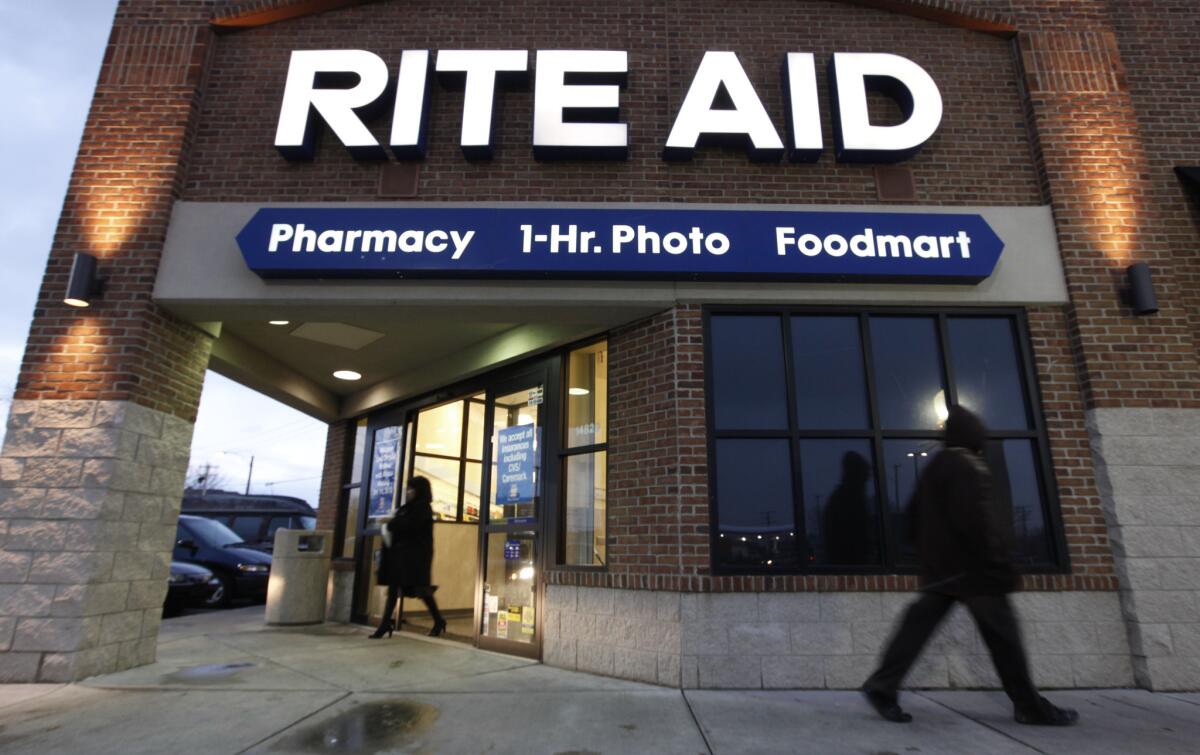Walgreens to buy rival Rite Aid for $9.4 billion, creating drugstore giant

Rite Aid shares climbed after a report that Walgreens agreed to buy the drugstore chain.
Walgreens Boots Alliance Inc. on Tuesday agreed to buy Rite Aid Corp. for about $9.4 billion, combining two of the nation’s largest drugstore chains as they bulk up to better compete in the rapidly changing healthcare industry.
Walgreens has about 8,200 stores throughout the United States, including 637 in California. Rite Aid operates about 4,600 stores in 31 states, including 577 in California.
The companies didn’t say whether there would be store closures or layoffs after the deal closes. But they said “decisions will be made over time regarding the integration of the two companies” and that Walgreens “plans to further transform Rite Aid’s stores to better meet consumer needs.”
Rite Aid initially would continue operating under its existing name after the merger, which is expected to be completed in the second half of next year, the companies said.
It’s possible that the deal would invite U.S. antitrust scrutiny because Walgreens and Rite Aid are such big players in the industry. Store divestitures could result.
The other major player in the U.S. drugstore industry is CVS Health Corp., which has more than 7,800 stores — including more than 860 in California — and reported 2014 revenue of $139.4 billion.
In making the announcement after the markets closed, Walgreens said it agreed to pay $9 a share for Rite Aid, a 48% premium to Rite Aid’s closing stock price Monday.
The proposed deal follows a wave of mergers elsewhere in the healthcare industry, with insurers, hospital operators and pharmaceutical companies all combining to gain more leverage with suppliers and cut costs as the Affordable Care Act and other issues roil the outlook for revenues and profits.
In July, for instance, Anthem Inc. reached a $54-billion deal to buy rival Cigna Corp. and create the nation’s largest health insurer.
In the drugstore sector, “our approach is to advance and broaden the delivery of retail health, well-being and beauty products and services,” Walgreens Boots Alliance Chief Executive Stefano Pessina said in a statement.
“This combination will further strengthen our commitment to making quality healthcare accessible to more customers and patients,” he said.
Walgreens executives are scheduled to discuss the deal with Wall Street analysts and report the company’s fiscal 2015 financial results Wednesday. Analysts estimate the company will report revenue of $103.5 billion, according to FactSet Research Systems Inc.
Rite Aid had revenue of $26.5 billion in its fiscal year ended Feb. 28.
The Affordable Care Act has spurred much of the healthcare industry’s merger spree. Health insurers want to add financial muscle to take advantage of rising revenue from the health law and a growing enrollment of Medicare and Medicaid patients.
The healthcare companies also see consolidation as a way to reduce costs and cope with limits on their earnings under Obamacare.
But some observers questioned how much the public is being helped by having fewer players in each of the health industry’s major industries.
Companies can make the argument that a larger company is necessary to negotiate better deals, but that might not translate to a boon for consumers, said Carmen Balber, executive director of Consumer Watchdog.
“It’s fair to assume that drug prices will increase for consumers because of this merger,” Balber said. “There are less companies negotiating with the pharmacy managers, and there are less companies negotiating with the pharmaceutical companies.”
In downtown Los Angeles, where Walgreens and Rite Aid stores face off across the intersection of 7th and South Hope streets, Jeffrey Portnoy said his only worry about Walgreens buying Rite Aid was the effect on drug prices.
“I get one drug, which is what I came in for, and it’s a very low price,” the 61-year-old Temple City resident said. “I’m wondering if I’ll get the same price at Walgreens.”
Farrah Siganporia, 27, is a Chicago transplant who moved to Los Angeles a year ago. In her hometown, she said, there’s a Walgreens on every corner, and she was looking forward to seeing the Chicago-area chain expand in her new city.
“It’s consistent,” said Siganporia, a consultant, of Walgreens products. “You know if you go to a Walgreens in any city, it’ll be there.”
Vishnu Lekraj, senior analyst at the investment research firm Morningstar, said the deal allows Walgreens to increase its geographic footprint, especially in the Northeast, where Rite Aid — which is based in Camp Hill, Pa. — has developed a strong presence.
Becoming a larger company also would give Walgreens more leverage and purchasing power with pharmaceutical suppliers, he said.
“They’re already pretty sizable as it is,” Lekraj said. “They’re probably the largest purchaser of pharmaceuticals in the world, and this is going to make them even more.”
He also said there would likely be a review of the stores’ overlapping coverage areas and that the Department of Justice would require them to shed some stores in certain regions, including California.
Walgreens, based in Deerfield, Ill., last December acquired the part of European drugstore chain Alliance Boots that it didn’t already own.
Alliance Boots was led by Pessina, an Italian billionaire, who later took over Walgreens’ leadership and made it clear his company was open to doing major deals to adapt to the rapidly changing healthcare marketplace.
On Tuesday, Pessina said marrying Walgreens and Rite Aid “will create an even better network with more health and wellness solutions available in stores and online.”
Walgreens overall has about 13,100 stores in 11 countries, and it operates a leading pharmaceutical wholesale and distribution network with sales in 19 countries. The company employs about 370,000 people. Rite Aid has about 89,000 employees.
Walgreens’ stock closed Tuesday at $95.16 a share, up $5.68, or 6.4%. Rite Aid shares closed at $8.67, up $2.59, or 43%.
[email protected]
[email protected]
More to Read
Inside the business of entertainment
The Wide Shot brings you news, analysis and insights on everything from streaming wars to production — and what it all means for the future.
You may occasionally receive promotional content from the Los Angeles Times.












